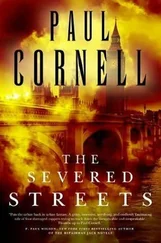“The fuck you aren’t.”
“It’s your conscience.” Brown looks at him, uncomprehending.
“Where’s the Carol Wright case?” says Worden.
“Hey, I’ve got to type the prosecution report for Nina Perry…”
“That was last month.”
“… and I got a warrant out this week on my boy Clayvon, so gimme a fucking break already.”
“My heart pumps purple piss for you,” says Worden.
“I didn’t ask you about Clayvon Jones, did I? What’s new with Carol Wright?”
“Nothing. I got my dick in my hands on that.”
“De-tec-tive Brown…”
Dave Brown pulls open his top right drawer and grabs the.38, pulling the gun halfway out of the holster. Worden doesn’t laugh.
“Gimme a quarter,” says the older detective.
“What the hell for?”
“Gimme a quarter.”
“If I give you a quarter, will you shut the fuck up and leave me alone?”
“Maybe,” says Worden. Dave Brown stands up and fishes a coin from his trouser pocket. He throws the quarter at Worden, then sits again, burying his face behind the magazine. Worden gives him a good ten seconds.
“De-tec-tive Brown…”
THURSDAY, OCTOBER 13
At its core, the crime is the same.
This time she is shot, not stabbed or garroted. This time the small frame is just a bit heavier and the hair is down, not pulled back in braids with a brightly colored beret. This time the vaginal swabs will provide proof of the rape in the form of seminal fluid. This time she did not disappear while walking to a library but to a bus stop. And this time the dead girl will be a year older, twelve instead of eleven. But in every important way, it is the same.
Nine months after Latonya Kim Wallace was discovered behind a Reservoir Hill rowhouse, Harry Edgerton is once again staring at an act of unequivocal evil in a Baltimore alley. The body, fully clothed, is crumpled at the edge of an old brick garage foundation behind a vacant rowhouse in the 1800 block of West Baltimore Street. The single bullet wound is to the back of the skull-a.32 or.38 from the look of it-fired at close range.
Her name was Andrea Perry.
And her mother knows when she watches the evening news and catches a glimpse of the ME’s attendants carrying the gurney out of an alley a block away from her Fayette Street home. Andrea has only been missing since last night, and the unidentified victim on television is initially believed to be an older girl, possibly a young woman. But her mother knows.
The identification process at Penn Street is achingly painful, hard even for the ME’s attendants, who can do this sort of thing four or five times a day. Later that day in the homicide office, Roger Nolan has barely started to interview the mother when she breaks down uncontrollably.
“Go home,” he tells her. “We’ll talk tomorrow.”
At about the same moment, Edgerton stands in the autopsy room and watches another postmortem of another murdered child. This time, however, Edgerton is the primary detective. In fact, he’s the only detective. And this time, he tells himself, it’s all going to end differently.
But if the Andrea Perry case is now the exclusive property of the homicide unit’s consummate loner, it is also a contradiction in terms: behold, the one-man red ball.
The Andrea Perry murder has all the earmarks of a major case-a dead child, a brutal rape and murder, a lead story on the six o’clock news-yet this time there are no special details, no herd of detectives at the crime scene, no second-day cadet searches. This time the brass is nowhere to be seen.
It might have gone this way even if someone other than Edgerton had taken the call. Because once already this year, D’Addario’s men had spent themselves in a communal fight, gathering the entire shift for an absolutely essential case. For one little girl, they had called in extra troops from the districts. For one righteous cause, they had pursued their best suspects for weeks and then months, sacrificing other cases in the campaign for a single, small life. And none of it had mattered. The Latonya Wallace case had gone sour, reminding every man on the shift that all the time and money and effort mean nothing when the evidence isn’t there. In the end, it was an open file like any other-a special tragedy, to be sure-but an open murder now in the care of one solitary detective.
Success is its own catalyst; failure, too. Without any arrest in the death of one child, the same shift of detectives had very little to deliver in the death of another. For Andrea Perry, there will be no general mobilization, no declaration of war. It is October; the arsenal is empty.
That it is Edgerton’s case simply makes all of this easier. Of all the men on D’Addario’s shift, he is the only one who would never think to ask for more troops. Nolan is with him, of course; Nolan is always with him. But beyond the sergeant, everyone else in the squad holds to his own cases. Even if Edgerton wants their help, he wouldn’t know how to ask. From the crime scene forward, he is on his own: So be it.
From those first moments at the scene, Edgerton tells himself he will not make the same mistakes that he believes are buried in the Latonya Wallace file, and if he does, they will be his alone to deal with. He has watched Tom Pellegrini waste most of a year kicking himself for investigative flaws, real and imagined. Much of that is the kind of second-guessing that accompanies any unsolved case, but some of it, Edgerton knows, has to do with Pellegrini’s feeling that the red-ball treatment had taken away control of the case. Landsman, Edgerton, Eddie Brown, the detail officers-every one of them had become a force for Tom to reckon with, particularly the veteran detectives who had so much more time than Pellegrini and, as a result, tended to influence the case to a greater degree. Well, thinks Edgerton, that was Tom. I won’t have that problem.
For one thing, he has a crime scene-not just a site where the child’s body has been dumped, but a bona fide murder scene. Edgerton and Nolan had taken the call alone, and for once they had taken their goddamn time with the body. They made sure to do everything in the proper order, to let the little girl be until they were absolutely ready to move her. They bagged the hands at the scene and carefully chronicled the exact array of clothing, noting that while she was fully dressed, her jacket and blouse seemed to have been improperly buttoned.
Working closely with the lab tech at the scene, Edgerton managed to pull several hairs from the victim’s blouse, and he carefully noted even the smallest scars and injuries. Walking the length of the alley, he found a single.22 casing, though the head wound appeared to be the result of a larger caliber. With a wound to a fleshy part of the body, a detective can’t really tell, because the skin expands at the point of contact and then returns to its shape after the bullet passes, leaving a smaller hole. But a head wound retains an accurate circumference; chances are good that the.22 casing had nothing to do with the murder.
There was no blood trail whatsoever. Edgerton carefully examined the victim’s head and neck at the scene, satisfying himself that she had done all of her bleeding right there against the low brick foundation. In all probability, she had been led into the alley, forced to kneel down, and then shot, execution style, in the back of the head. Nor was there an exit wound, and a clean, remarkably unmutilated.32 round is subsequently recovered at the autopsy. In addition, the vaginal swabs will later come back positive with the seminal fluid of a secreter-a male whose ejaculate contained sufficient blood to type or DNA-test against any potential suspect. In contrast to the Latonya Wallace case, the killer of Andrea Perry has left behind a wealth of physical evidence.
Читать дальше












